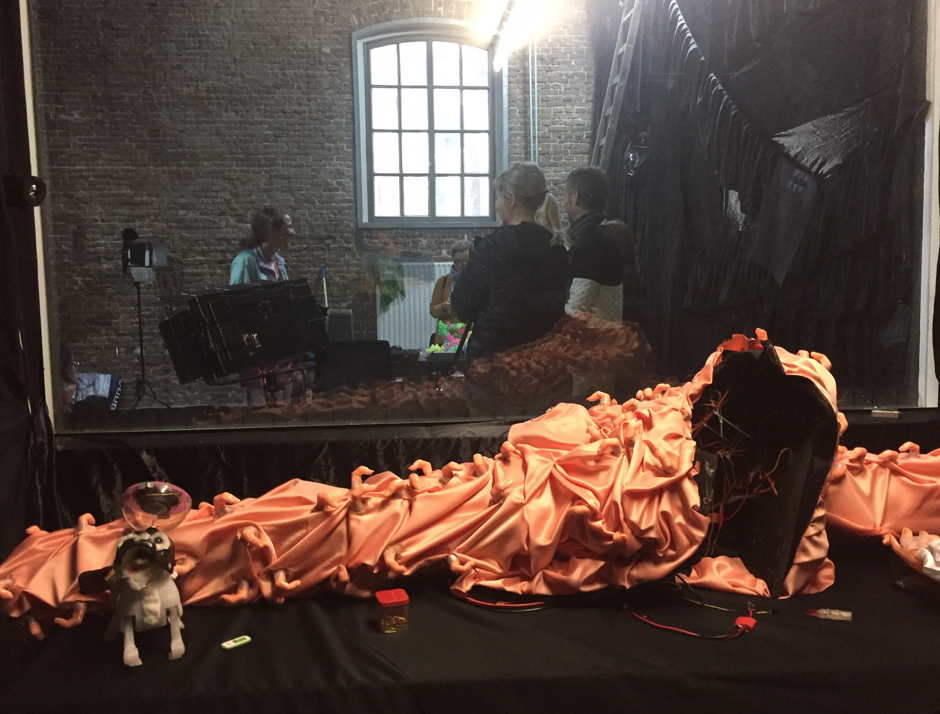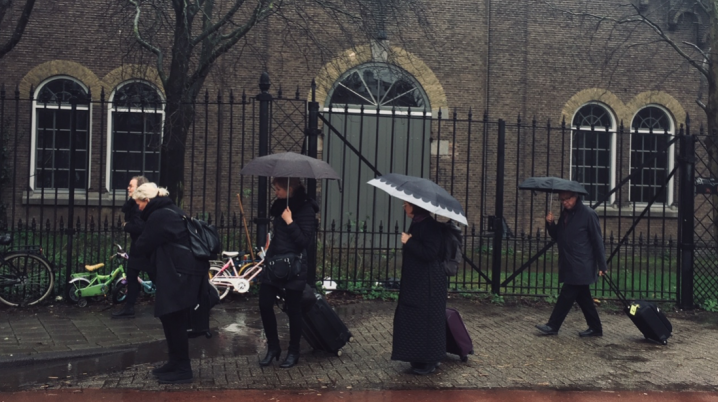
From hard facts to ephemeral values
TransArtists visited Finland last year to contribute to the national artist residency network meeting. Being there we noticed a great interest in the Dutch residency field. As a follow-up this year, we organised a series of encounters between Dutch and Finnish residency operators in The Netherlands in collaboration with the international visitors program of DutchCulture. During an inspiring week we traveled with a Finish residency delegation across the Netherlands and peeped into the kitchen of their Dutch colleagues. Here practical knowhow and experiences about operating a residency program were exchanged. We spoke about concrete and ephemeral qualities that form the heart of a program. Themes as legacy, remoteness, friendships and hospitality where touched upon. During the talks potential new partnerships and networks were born.
Meet the Fins!
Who are the Fins? Get to know our guests here. During a rich and intense program of visits and talks we introduced them to their Dutch residency colleagues. Together we discussed residency values and exchanged ideas of possible future collaborations.
Johanna Tuukkanen (Kuopio, FI). She is the artistic director of ANTI, a contemporary art festival. They produce a year-round program of artist residencies and cultural projects held annually in Kuopio, Finland. Here artists from around the world inhabit the spaces of public life – homes, shops, city squares, business, forests, lakes – and directly engage communities and audiences in the making and showing of their work.
Jaakko Toivonen is the artistic director of ITAK (Regional Dance Centre of Eastern Finland) curates their seasonal programme and two contemporary dance festivals. He is also part of setting up The Old Mine Residency (Outokumpu, FI). An international residency for artists and researchers in North Karelia in Eastern Finland. Accommodation and work areas are located in the Old Mine area, one kilometre from the centre of Outokumpu.
Marja Karttunen is a board member of Saastamoinen Foundation (Helsinki, FI). This foundation promotes the work of actors in the field of science and art, and by networking both in Finland and internationally. Through its residency program, the foundation promotes international networking by providing their guests the opportunity to meet local artists and researchers and to acquaint themselves with the local scene in the arts and sciences.
And last but not least: Minna Canth's House (Kuopio, FI) This future artist residency in the honour of the legacy of Finnish author, journalist and social activist Minna Canth came with a delegation of three. Anja Lappi, Seppo Karvinen &. Sari Rovamaa (FI) were here to be inspired by the Dutch residency field.
During this program we were warmly welcomed by the following residency organisations in The Netherlands. Rijksakademie (Amsterdam, NL) Annelie Musters, Suns and Stars exhibitions - (Mobile, NL) Marjoca de Greef. M4 Residency - (Amsterdam, NL) Monica Aerden, EKWC - (Oisterwijk, NL) Ranti Tjan and De Fabriek - (Eindhoven, NL) Koen Dijkman.
Cherry picking
Here are some of the insights of the program we would like to share. We’ve summed them up in topics so you can pick your residency story consisting of sometimes useful and unexpected insights on topics residencies deal with on a day-to-day basis.
At least we have a roof to keep out the snow
topic: building & Legacy
Legacy can be a blessing and a burden. Here are some thoughts that came up reflecting on this topic.
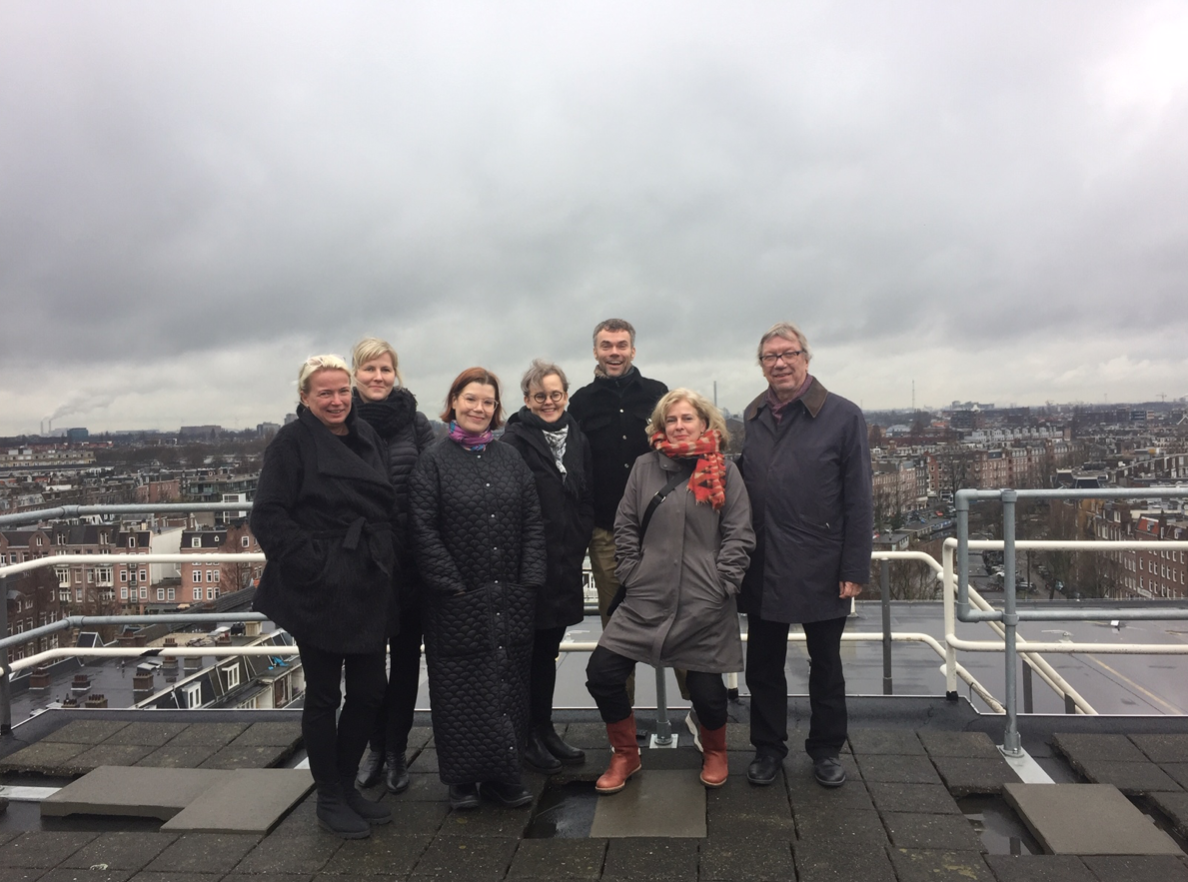
Holding on to original values can be challenging in an ever-changing surrounding. M4 residency in Amsterdam managed to do so. Once erected from a squatters ideology it now finds itself in the middle of a gentrified area. We are the last fort standing director Monica Aerden mentions with pride. After the erection of a giant Food Hall in a converted tram remise house next door prices rocketed sky-high in this neighbourhood and replaced social housing for hipster shops and restaurants. A harsh contrast with the residency. Everything you see… she knocks on wall …has been built by us. This residency is located in a former typeface factory. In the 80’s squatters took over; later the municipality of Amsterdam made a contract with the squatters and they became responsible for the building. One piece of advise the director of M4 can share with us: If you start; don’t talk about money. Talk about vision and content. A space is a heritage, not something you design. If you have to start something start from here.
At EKWC Oisterwijk director Ranti Chan isn’t interested in the heritage of his building. We needed an building big enough to fit our ambitions. In search for a new space for the international ceramic residency program he found the old leather factory in the small town to Oisterwijk. Within a few years he has transformed the space into a large open plan residency that can accommodate 16 artist at the same time. Who? No ceramic artists please! Here we invite artists that have never dealt with clay in their live. From the huge pile of applications each year we split the candidates in two. 99 percent of the applicants offer us a great plan and 1 precent writes an impossible idea. We chose the last.
The Rijksakademie in Amsterdam is located inside a monument, known as the ‘Kavallerie-Kazerne’. A cavalry barrack. During our tour through the building we learn how the architect dealt with the restrictions of building a residency inside a monument. Studios and workshops are now located in former stables. But some functionalities didn’t fit the existing structure. For this; two new towers have been built housing the collections, library, artist documentation, project rooms and offices. The team of the future residency Minna Canth's House has been dealt the same hand. They will also have to build up their residency within a monument: the former house of writer Minna Canth in Kuopio. Director Anja Lappi concludes: At least we have the building as a starting point; you don’t want to start in the snow without a roof over your head. Her team is dedicated; perfectly self- typecast to make this new residency happen.
Next to a physical place they choose to deal with the legacy of a person. During a round table meeting at De Fabriek in Eindhoven they exchange benefits and disadvantages of building a program around a famous person with The Vincent van Gogh Huis; an arts centre built on the native soil of one of the most famous artists in history inviting resident artist to work with the legacy of Vincent van Gogh.
A bit like Twin Peaks
Topic: Location
Remote or not; how to play your strengths? Where you are located can be a big part of who you are as an organisation. In a cabin in the woods or part of a tech campus in a major city. What an artist will see when he looks out of his/her window and what he will encounter walking out of the door has great influence on the work that is being made; and the research that can be done.
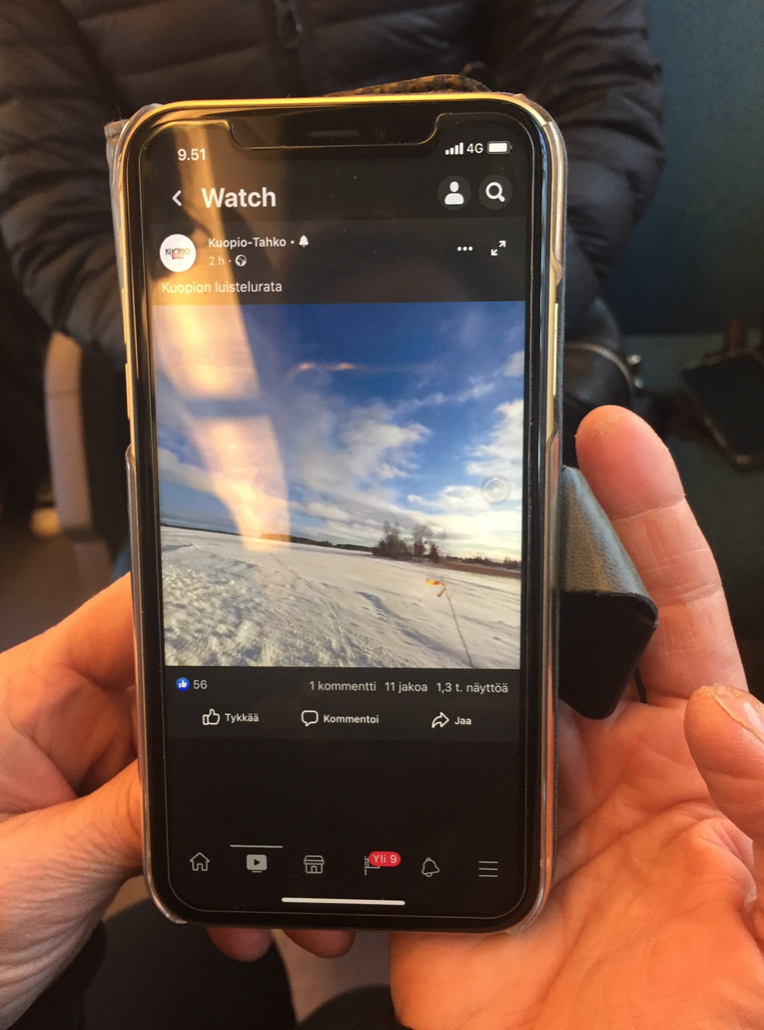
Remote is just a word. You need to trust in the power of the place and own it Anja Lappi mentions. Once you walk out into the central square of the village and look down you can read : ‘Kuopio, the center of the world’. We are in the middle of nowhere. But this is not what we call it. She laughs and shows an endless landscape of snow and sky. Artist come here from the big city and hear the sound of their own footsteps for the first time. Quite a haunting experience for one of the residents! Jakko who runs Old Mine Residency agrees. This International Residency for artists and researchers is located in Outokumpu, North Karelia in Eastern Finland. It is also very isolated and quite hardcore. A bit like Twin Peaks! Their residential building served in the 1970s and 1980s as the office space for the technical mining group. Right now this new residency is looking for collaborations with other residencies. Perhaps another mine city. At the moment they are gathering information to develop further collaborations, perhaps with residency partners in The Netherlands. Johanna who just finished her PhD on working with local conditions runs the funky ANIT festival and knows how to play remote to her strength.
Friends with benefits
Topic: Networks
Soft networks of friendship from neighbours, to regional partners to international networks empower a residency and make it resilient in times of change and challenge. They are formed by hospitality and reciprocity .
Also alumni -former residents or visitors- are part of this. They act as an ambassador for your organisation.
EKWC experiments with new business and friendship models that strengthen the ties with the local community. When we enter the residency two men prepare coffee for the group of residency hosts. They are businessmen selling coffee and can use a space for their work for free. Only condition: to serve coffee for all residency guests. For free.This is one of the examples of the unorthodox approach in which Ranti Tjan runs EKWC. A new business model engaging the local community. Between two sips op coffee Ranti mentions they are …perhaps the best residency in the world. No these are not his own words. The New York Times wrote this. But… being Dutch he raises a book - a full PHD report called ‘demystified’ that supposed to demystify this idea …. All it does is add more awe.
Riet van Gerwen, co-founder of Sea Foundation has created a network of technical workshops and facilities in the vicinity of the residency. This is part of our DNA. An artist who would for instance like to explore the possibilities of textile will be introduced to the neighbouring Textiel Museum or a sound artist is connected to the sound studios in Tilburg and…ceramic artists to EKWC. Most of our partners are located in the vicinity of a ten minutes bike ride. Besides this hyper local network we have been able to sustain several international collaborations; including with Finish partners. This is part if our survival strategy. Collaborating with foreign partner is for us the only way of surviving because this opens up international funding opportunities.
AiR Platform Brabant gathered together at De Fabriek to meet up with their Finnish colleagues. After short introductions and a tour around the impressive open space of this Eindhoven based initiative, it was the shared dinner, brought in from the local Chinese restaurant that got the actual conversation going. Exchanging customs, stories and fun over a meal, for this reason the kitchen is the most important shared space of a residency in function. Cards changed hands for conversations to follow up online soon.
New forms of making
Topic: Workshops
Technical workshops challenge artists into experiment, cross-overs, encounters and failures. This is a good thing.
Inside the Rijksakademie we are welcomed in one of the technical workshops run by Kees Reedijk. It’s a universe of wires; keyboards, 3D prints and moving robotic fingers. Here old machines, cutting edge technology are wired up and rebuilt into artworks; thought up by the residents of the Rijksakademie. Mister Reedijk is one of the technical specialists here who advises the artists. There is a frequent cross over collaboration between workshops here. He shows us the work of resident Mette Sterre. A sea of plastic moving fingers waves on the table. It’s a prototype of her Enchanted Field Research _Secret Meetings that shape the World. Mette: I am a maker and a researcher using robotics. Soft robotics. Because of the close and fluid collaborations and crossovers between the various technical workshops; we are are able to experiment and research new forms of making.
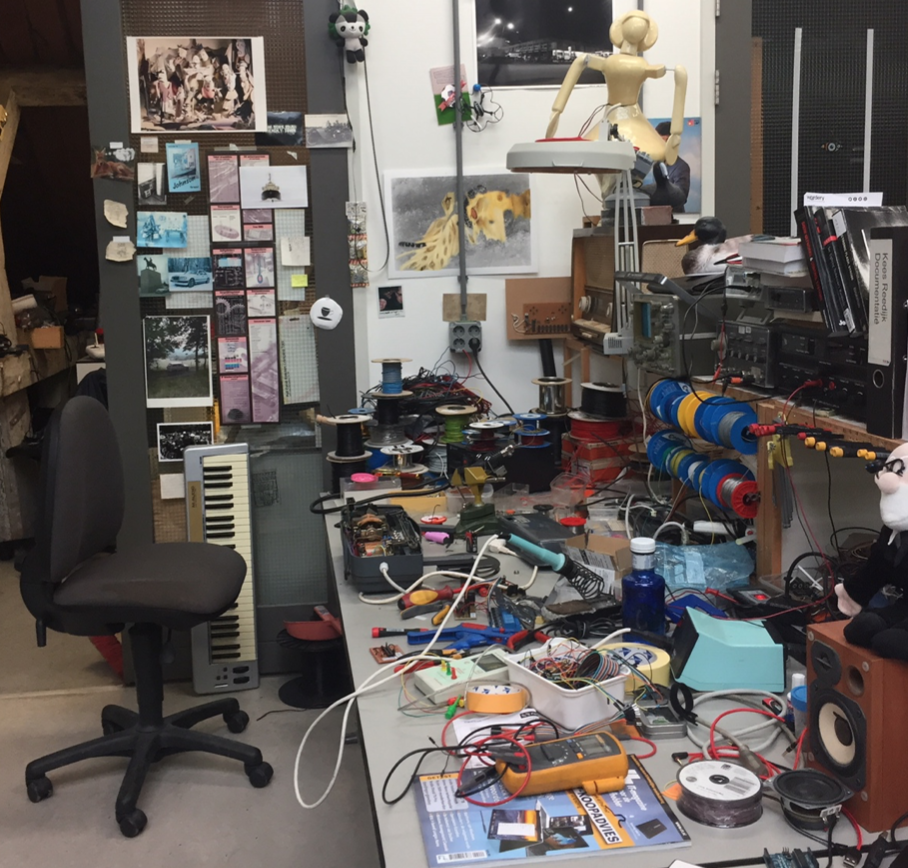
Ranti Tjan also embraces new forms of making…. Each piece constructed here functions as a talking piece. he puts his hand and a huge elephant leg: a cracked sculpture piece. Like this one. It is a sculpture; lifted with a crane when still wet and dropped from high altitude on the floor. The technical workshops at EKWC are built around making mistakes. Besides being a residency EKWC is a center for expertise. By setting all the conditions to make mistakes and accidents to happen we encourage our guests to push this material beyond its usual boundaries. This makes for new knowledge and ways of working with clay. Not only the artist and clay follow this principle. Also all equipement that comes in; first thing that happens is the manual is thrown out. Why? Because the technicians will get to know the machines and improve them according to their needs.
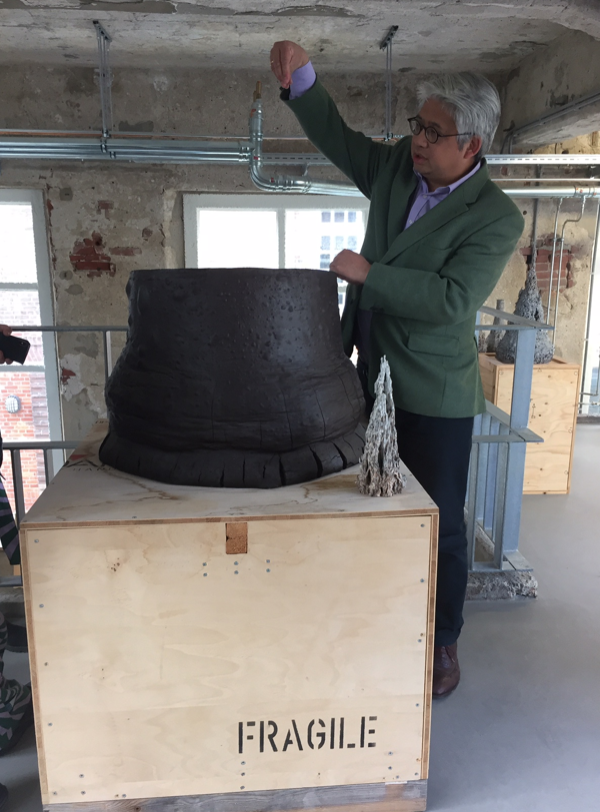
take away
After a great week the Finish residencies returned home to work out the plan for their new residency at Kuopio- The center of the world. Perhaps it was not the hard facts and figures that will resonate in drawing up the blueprint for a residency in Finland but more so the immeasurable values like hospitality; empathy, vision, network, friendships; people. In visiting many residencies those qualities stood out far above others as the strong core of these programs. Under the pressure of lack of funding, size and shape of a building can shape shift; as long as its core remains. But more so the notion that running a residency is a process; a negotiation with local conditions; with a vision and eye and heart for the guest. From this starting point a program can shape naturally over the course of time. We will keep in close contact with the network and update you on future moves.
